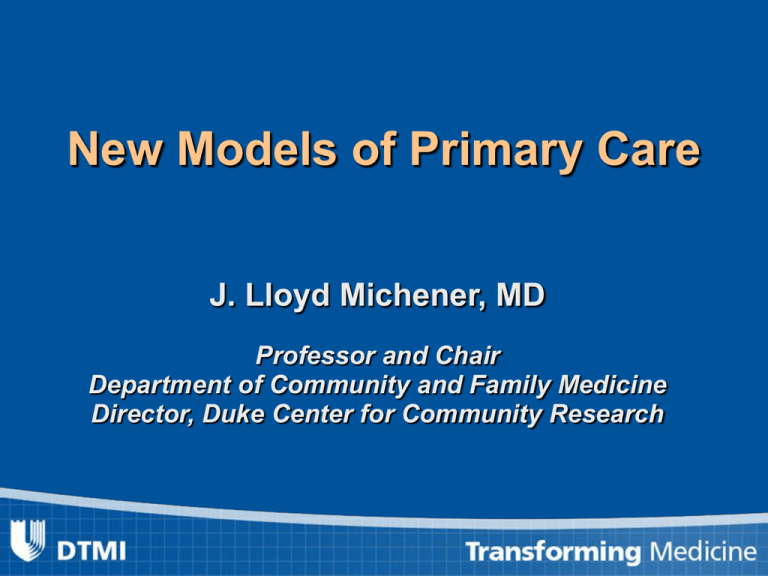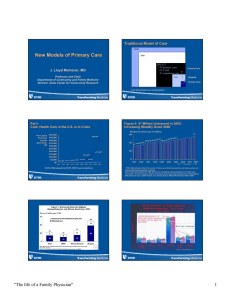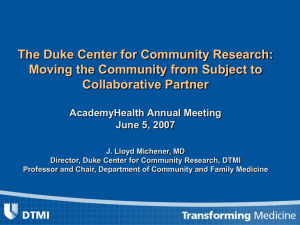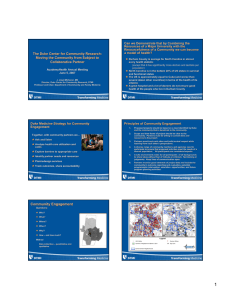New Models of Primary Care J. Lloyd Michener, MD
advertisement

New Models of Primary Care J. Lloyd Michener, MD Professor and Chair Department of Community and Family Medicine Director, Duke Center for Community Research Traditional Model of Care 1000 800 250-217 113 primary care 65 CAM 21 outpatient care Primary Care 9-8 Hospital 1/1 Kerr White Health Care Ecology Model Tertiary Care Part I Cost: Health Care in the U.S. is in Crisis Per Capita Personal Health Spending, US $50,000 $45,000 $40,000 $35,000 $30,000 $25,000 $20,000 $15,000 $10,000 $5,000 $0 $44,244 $22,482 $11,431 $29 $80 1940 1950 $143 1960 $2,566 $346 $1,059 1970 1980 1990 2000 $5,555 2010 HCFA (1992) adjusted to HCFA 1998 10-year projections 2020 2030 Figure 4. 47 Million Uninsured in 2005; Increasing Steadily Since 2000 Number of uninsured, in millions 56 60 40 33 31 33 35 35 39 40 40 41 44 42 43 40 40 41 44 45 46 47 20 0 1987 1990 1993 1996 1999* 2002 2005 2008 2011 Projected 2013 *1999–2003 estimates reflect the results of follow-up verification questions and implementation of Census 2000-based population controls. Note: Projected estimates for 2006–2013 are for nonelderly uninsured based on T. Gilmer and R. Kronick, “It’s the Premiums, Stupid: Projections of the Uninsured Through 2013,” Health Affairs Web Exclusive, Apr. 5, 2005. Source: U.S. Census Bureau, March CPS Surveys 1988 to 2005. The Graying of America 1995 2010 2030 Institute for the Future, Health and Health Care 2010 (2000) Prevalence of Obesity & Diabetes in the U.S. 1990/1991 2000 Obesity No Data < 10% 10%-14% 15%-19% 20% Diabetes No Data < 4% 4%-6% > 6% Mokdad et al., JAMA 286:1195–1200, 2001 Hospitalization Rates Are Dropping From 1980 to 2004, US days of inpatient care per thousand plummeted across all age groups: Age Under 15 15-44 Change - 40% - 60% 45-64 65 and over - 63% - 50% Source: Agency for Healthcare Research and Quality, 2005 National Healthcare Report Hospitalization rates in primary care 1.8 1.6 1.4 1.2 1 72% 0.8 0.6 0.4 0.2 0 1978 1979 1980 1981 1985 1989 1990 1991 1992 1993 1994 Admitted Source: Stafford RS, Saglam D, Causino N, Starfield B, Culpepper L, Marder WD, Blumenthal. Trends in adult visits to primary care physicians in the United States. Arch Fam Med. 1999;8:26-32. Preventable admissions vary Hospitalizations for Ambulatory Care Sensitive Conditions Source:The Quality of Medical Care in the United States: A Report on the Medicare Program. The Dartmouth Atlas of Health Care 1999. The Center for the Evaluative Clinical Sciences Dartmouth Medical School New Models New Models of Care 1000 Community Care 800 • health education, advisors, care managers, internet access, minute clinics, urgent care 250-217 113 primary care 65 CAM 21 outpatient care Primary Care • teams, chronic care models Hospital/secondary care 9-8 • hospitalists, direct access 1/1 Tertiary Care • hospitalists, discharge to primary care Innovative models Multi-disciplinary teams in community settings neighborhood-based clinics school-based clinics in-home medical care and case management Designed and delivered together with community partners Innovative financing built on partnerships Walltown and Lyon Park Clinics Duke-Durham Neighborhood Partnership: Neighborhoods ask for access to care Population: African-American, new Latino population, low-income, transient, uninsured Health characteristics: high ED use; inconsistent primary care, high risk health behaviors; substance abuse; depression/anxiety Partners: Calvary Baptist Ministries Walltown Neighborhood Association PAC-2 PAC-3 Lincoln Community Health Center Planned Parenthood of Central NC Community and Family Life and Recreation Center of the West End, Inc Self-Help, Inc Duke Community Affairs Duke Community Relations DUH CFM Neighborhood Clinics Keep costs low, easy access, locating clinics in neighborhood settings, NP/PAs as providers Duke Endowment, Duke University, Duke Hospital >10,000 visits projected for FY07 70% of visits are return visits (continuity) 37% of patients surveyed would have gone to ED High patient satisfaction – 4.7/5.0 Just for Us: Caring for Durham’s Older Adults in Public and Subsidized Housing 300 home-bound seniors and disabled adults in Durham senior low-income public housing, average age, 71, mostly women, AfricanAmerican, <$7K annual income, care fragmented Multiple chronic diseases, average 5 rxns, 44% also have mental conditions Care delivered by NP/PA, SW, OT, PT, RD in home Partners: City of Durham, Housing Authority Lincoln Community Health Center Durham Council on Seniors Duke Center on Aging Area Mental Health Agency Durham County Health Department Durham County Department of Social Services Duke CFM, SON, DUH, DRH, Center for Aging, Psychiatry The Duke Center for Community Research (DCCR) Moving the Community from Subject to Collaborative Partner Goal: Improve the health of the community through: —Community engagement in research —Integration of practices into research structure —Linking communities, practices, researchers Components: 1. Community Research Liaison Center 2. Community Health Research Training Center 3. Electronic Health Record A New Approach Understand the needs of your communities Identify the barriers to receiving care Test methods of improving access, outcomes, and cost in your practices and communities Some areas admit, some don’t Medical Discharge Rates Source:The Quality of Medical Care in the United States: A Report on the Medicare Program. The Dartmouth Atlas of Health Care 1999. The Center for the Evaluative Clinical Sciences Dartmouth Medical School DTMI Organizational Structure Duke Translational Medicine Institute DTM DTMI Administration DCRI DTRI DCCR DTRI Sullenger Education and Training Odd Ethics Pediatrics Biomedical Informatics P Biostatistics Nursing Core Laboratories Ginsburg, Weinho Regulatory Affairs Project Leaders and the Portal Office Duke as a Site DCRU New molecule Preclinical dev. First-in-human M Application in the community Phase II/III 1. Community Research Liaison Center The connection between Duke and local communities, practices, and organizations A virtual library: — For researchers to learn about communities — For community groups to learn about themselves — For practices to identify opportunities for improvement Outreach and training to assist communities with data and to connect communities with researchers 2. Community Health Research Training Center Train and prepare researchers to work successfully with communities Train and prepare learners/trainees to research successfully with communities Conduct formal regulatory training and testing for community engagement 3. DCCR Electronic Health Record Covers citizens of Durham County Captures data for Durham County Develop analytic techniques using data from the DSR Dealing with co-variates Meshing advanced laboratory data with long term outcomes Produce rapid & measurable improvement of community health status Can perform rapid turn-around intervention studies (V.J. Dzau 2006) http://communityhealth.mc.duke.edu/education/?/masterhealthscience







